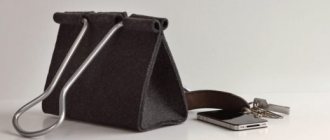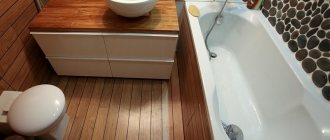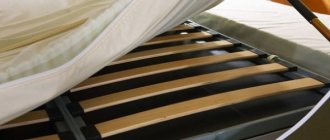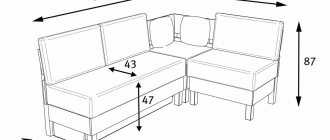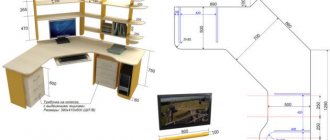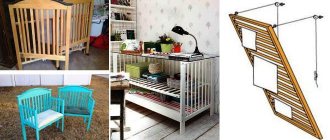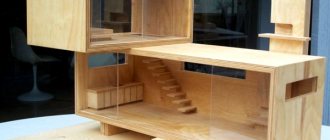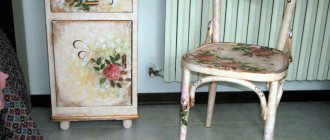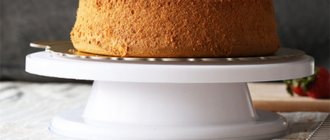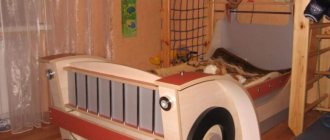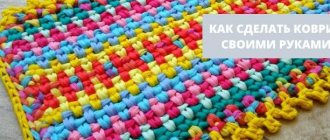What is an apron and why is it needed?
Apron - the distance from the tabletop to the upper set. Named after a common piece of clothing that protects the owner from dirt. It immediately protects the wall from dirt, splashes, and grease. Trying to do without an apron will not lead to anything good:
- the wallpaper will get dirty, wet, bubble, and eventually peel off;
- the whitewash or plaster will simply peel off, and the paint will be erased due to constant washing of the surface.
The apron is located throughout the entire work area in the kitchen, so it is always in front of your eyes while cooking - which means it should be attractive. That is why so much attention is paid to this issue - it is necessary to choose a durable, beautiful option that suits a specific design.
Requirements for apron material
When choosing modules in the catalog of kitchen aprons, you should pay attention to the characteristics of the selected material. The basis for creating a protective coating over the hob must meet a number of requirements:
- Strength of the material. The strong structure gives the material resistance to mechanical deformation.
- Moisture resistant. The presence of an apron requires frequent cleaning of the work area, and therefore the coating should not be afraid of moisture.
- High temperature resistance. The heat from the hob can damage some of the materials used to create backsplashes.
In addition, they pay attention to the appearance, presence of decor and environmental indicators. The manufacturing technology should not use toxic or flammable varnishes and paints.
Ceramic tile
The traditional version of a kitchen apron in our country. Nowadays, in construction stores, tiles are presented for every taste, color, size and budget, so choosing an option that suits the design will not be difficult.
At the moment, boar tiles, shaped like a reduced brick, are popular. Or small square tiles with hand-painted ornaments. Here lies one of the main disadvantages of a tiled apron - the seams.
Water, dirt, and grease get into the seams, which serve as an excellent home for bacteria - not the best proximity to the place where food is prepared. Even if you clean the seams often, sooner or later they will no longer look presentable and you will have to work with grout again.
The next disadvantage lies in preparing the walls for the tiles - they must be perfectly smooth. So smooth that you will have to invite a professional to level the walls, which will cost additional money. Why is that?
In the kitchen, the seams are filled with a special grout, the seam of which should not be more than 1.5 mm (for comparison, in the bathroom, the tile seam can reach 4 mm). If the wall is uneven, then laying the tiles will be very difficult, taking into account the fact that even within the same batch they may differ by a couple of millimeters in size.
For this reason, laying tiles on the backsplash yourself is also rejected - this should only be done by a professional. It’s better to spend money on a professional once than to spend years looking at a not quite evenly laid apron.
Both processes - preparing the wall and laying the tiles - are very dusty, so they are carried out strictly before installing the headset. But at the same time, a kitchen design project with calculated markings down to centimeters must be prepared. Ideally, the apron (any kind, not just tiled) should extend a centimeter under the upper and lower cabinets.
Tiles are a durable material that will last for many years. This will work to your advantage, since replacing such an apron is an even more labor-intensive process than simply installing it. In order not to be disappointed in your choice, you should give preference to ordinary smooth tiles without roughness or patterns, otherwise dust and dirt will accumulate in them, which will ruin the entire appearance.
Mosaic
A subspecies of a tiled apron can be considered one made of mosaic. It always looks expensive, elegant and beautiful. It is very rare in apartments, and there is a reason for this: preparation for mosaics is even more thorough, and this option has much more seams. As an option, use a mosaic panel - this will make it easier to install the apron, but it will not save you from the number of seams.
Dimensions
To determine the size, you should take into account the dimensions of the headset. As a rule, the entire wall between the upper and lower tier of the kitchen is closed. If there is a corner sink, it would be wise to protect it on both sides (and the wall too) so that water does not get on the coating.
As for the width, the apron is made with a margin; it should “go” a little behind the cabinets. Its height is usually 45–60 cm. But keep in mind that according to regulations, the distance between the gas stove and the hood must be at least 75 cm, so in this place you need to provide a protrusion that covers this space.
For a set that does not have a top row, you can lay out the cladding up to the ceiling.
MDF
The opposite of tiles are MDF panels - medium-density fiberboards. This is compressed wood shavings, which are covered with plastic film on top. This solution is very economical and easy to maintain and install - even an untrained person can handle it.
An additional advantage is that the MDF panel has no seams, which means you don’t have to clean them. In addition, under such an apron it is not necessary to level the walls to perfect condition, which means you can save on at least one specialist.
If you believe the reviews, the MDF panel will not last as long as tiles - about 5-7 years with good care, but replacing it will not be difficult. Usually such an apron is mounted on special strips, liquid nails or simply self-tapping screws, so replacing it will only take half an hour - and this is without dust. Due to the film on top, such panels are resistant to damage. They can even be washed with mild abrasive agents.
If you have doubts about your design abilities, in order not to make a mistake, you should choose a panel that matches the color of the tabletop - this option will always look neat and stylish.
Perforated panels
These panels are made from both MDF and PFC. They are ordinary boards, but with a large number of holes created for hooks on which potholders, ladles and other little things that the housewife needs at hand will be located. If necessary, hooks can be removed, added or simply repositioned at any time.
It looks comfortable, but moisture entering through the holes can even cause mold. Or, at a minimum, soften the glue and the walls, and the apron will simply come off.
Brick kitchen apron
Raw brickwork has made a comeback with industrial styles. This apron looks bright and interesting in a loft, Scandinavian interior, grunge, boho, and even some types of classic and country.
If you prefer bright accents, leave the classic terracotta shade. For a strict and elegant contemporary, paint the surface black or gray, and for light and delicate interiors – white or pastel colors. But the brickwork is textured and quite difficult to maintain, so in the area of the stove and sink it is better to cover it with a glass panel.
Glass
Glass is a new solution for backsplash design, but it is quickly gaining popularity. Glass adds lightness to the kitchen, while looking stylish and impressive. With its help you can create any design. There are several options:
- photo printing on glass will be expensive;
- ordinary, photo wallpapers, maps, atlases, children's drawings under glass - panoramic photographs look especially beautiful;
- fabric or lace - easy to implement, but very rare;
- drawing on the back of the glass or on the wall itself.
Glass gives limitless scope for imagination: you can combine absolutely any ideas with it - even cover an entire wall with coffee beans.
Usually they use only tempered glass with a thickness of 6 mm, which costs more than tiles and especially MDF. Another disadvantage is that the selected pattern may simply get boring - but in this case it can be replaced, since the mirror is placed on a frame. It is necessary to think through in advance all the necessary holes in the apron: for sockets or roof rails, since glass can only be drilled from the back side.
Fingerprints, drops and dirt are always visible on the glass, so you will have to wipe the apron frequently. The advantage is that it is very easy to care for - all you need is a microfiber cloth. The glass is most often solid, that is, it has no joints - and there is not even a chance that someone will get in there. Tempered glass is resistant to both damage and temperature changes, so its service life is practically unlimited.
Apron color: for a bright, classic and stylish kitchen
In this regard, the apron for the kitchen can be different - monochrome, shiny, lime, wenge and neutral. You can select it so that both the set and the apron have the same color. You can play with contrast when the wallpaper and apron are made in different colors, or you can merge them together. Basically, the ideas are endless.
Since modern kitchens are most often decorated with wallpaper, the question arises: can the apron match their color? Both the apron and the wallpaper can be matched to the same tone in the following cases:
- You need to expand the space and create the effect of a “light kitchen”. In this case, both the wallpaper and the color of the apron should be chosen the same. For high-tech and modern style, you can choose white or wenge-colored tiles for the walls and the same snow-white and wood-effect apron. In this case, the color of the latter may differ in shine.
- The furniture and wall decoration have radically different colors. For a blue kitchen or a kitchen decorated with a lime shade, as well as sandy walls, it is better to choose the same calm shade of the apron. A red apron and lime will look good when the set has the same variegated color, but the walls are classic white. In this case, the apron will play the role of a unifying element.
A practical solution is when the set and apron are matched in the same color. Here design ideas can be anything. You can match it to the color of wenge or the same tone as the countertop. Contrasting colors will also look good. For example, for a blue tabletop you can look for an equally rich apron. But the popular shade of lime in which the facade is made is best complemented with an apron of a calm shade.
Which apron should I look at if photo wallpaper is used on one wall? There are two options here:
- Use the main color in which the photo wallpaper is made. This method is good if your kitchen is of impressive size. You can safely choose bright colors for your apron. For example, original photo wallpaper with a macro image of an orchid should be complemented with an apron in rich pink or lime color. That is, those shades that predominate in the picture.
- Use a neutral shade. A properly selected apron will set accents and make the kitchen look fresher. If photo wallpaper is hung in a small kitchen and serves as the main accent, you should not choose the same colorful protection. It is better to look at wall panels in pastel and wenge tones.
Mirror
An option for a glass apron can be a mirror. It looks very unusual and is perfect for small kitchens that need to at least visually expand the space. It has all the advantages of glass, but you will have to wipe the mirror much more often, since every speck of dust is visible on it - especially if you add lighting to the work area.
Plastic panels for kitchen
Kitchen aprons made of plastic are used quite often. The material is affordable and comes in a wide variety of colors and textures. The smooth surface and moisture resistance allow for wet cleaning as needed. The disadvantage of the practical use of a plastic apron for the kitchen is that the coating is easy to scratch, and some types of dirt cannot be erased.
Plastic
The most budget-friendly and simplest option that can be changed at least every year is plastic. Construction stores sell plastic panels for every taste and color; their installation is absolutely simple: you just need to coat the back side with universal glue or liquid nails.
The service life of such a panel is long, but the appearance may deteriorate, for example, the color will fade in the sun. If you do not use abrasive cleaning agents, scratches should not appear.
There is one minus - it is not suitable for all stoves. If the stove is gas and without a hood, then there is a risk that the plastic will simply heat up and melt. And in appearance, this option is more suitable for a dacha or a rented apartment: budget-friendly and neat.
Kitchen apron made of plastic
To create a plastic apron, special heat- and moisture-resistant panels are used, which are mounted directly into the profiles. They can even be installed on an uneven wall, just like regular exterior cladding, and you can do it yourself. The surface can be easily washed and painted, and it looks quite neat.
But plastic cannot be used with a gas stove, and its service life is a maximum of several years. It fades, turns yellow, fades and is scratched, but it is very cheap. Usually such aprons are made at summer cottages or in temporarily rented houses.
Steel
An unusual option, but also has a right to exist. Fireproof, looks trendy in fashionable urban styles such as loft and hi-tech. The steel can be either polished or patterned. This material is durable: it will not fade, will not require polishing, and it is almost impossible to damage it.
A steel apron is as hygienic as possible, since germs and bacteria simply do not have a chance to settle and multiply on its surface.
The only negative is that it requires special care, otherwise cracks and scratches may appear from careless handling. Metal is a cold material; some may find it unfriendly.
Material for creating an apron
Today, any buyer has the opportunity to first familiarize himself with a photo of a kitchen apron, its main materials and properties. In construction supply stores, each client will be offered a huge range of products: any color and composition, texture and cost. The most common options are:
- Ceramic tile.
- Tempered glass modules.
- Plastic panels.
- MDF panels.
- Artificial or natural stone.
- Mirror panels.
- Mosaic covering.
It is worth noting! Gypsum panels or decorative plaster are very rarely used. Such materials can decorate any room, but they do not meet the requirements. Plaster and gypsum stucco are used only for decorative kitchen or dining areas.
Natural or artificial stone
These options are more expensive, but also more solid. Usually they are chosen together with a countertop, so if you have a wooden, glass, or steel countertop, you shouldn’t look in the direction of a stone apron - it will turn out to be bad taste.
Stone, whether natural or artificial, is a very durable material: it is not afraid of moisture, fire, or temperature changes. Some even manage to cut on stone countertops, but this only ruins the knives. It requires careful care without the use of acids and abrasives, but traces of drops and grease on such material will be almost invisible.
Kitchen apron made of natural stone
Natural stone is a stylish and luxurious solution for expensive classic interiors. For finishing, thin slabs 1.5-2 cm thick are used. These are mainly granite or marble: they are durable, beautiful, and are not afraid of fire and temperature changes.
The perfectly smooth surface of granite is practically without pores, so it does not absorb odors, dirt and grease. In addition to the variety of shades, slabs always differ from each other, and no two identical minerals exist in nature.
Granite can be not only dark, but also gray-pink, blue, brown, yellow and even almost white. The shades of marble also differ, and it can even cost less, depending on the deposit.
There are two main disadvantages: the high price of natural stone and its heavy weight, which overloads the base and complicates installation. Such an apron will require delicate handling and care, and especially marble with higher moisture absorption.
Acrylic
Roughly speaking, acrylic is a plastic that can depict either marble or oak. It costs less than stone, but is still an expensive option. Acrylic slabs are joined together virtually without seams, so hygiene is in order. Acrylic itself is a good material: it does not fade, does not fade, does not stain, and is durable. Like glass, it gives enormous scope for imagination. But, since it is based on polymers, this imposes some restrictions:
- may melt next to the stove, as it is afraid of high temperatures;
- does not like aggressive and abrasive detergents.
Acrylic looks beautiful in the kitchen, for example, on facades, but for an apron it is not the best option.
Kitchen apron made of wood
Natural wooden panels are rarely used for kitchen splashbacks, because even the most durable wood will be expensive and will not last long in such conditions. But chipboard or MDF boards with a laminated coating can cope with kitchen loads quite well.
Such an apron can be made completely under the tabletop, so that the composition looks holistic and harmonious. The thickness of the slabs is from 0.5 to 1.5 mm, so they do not take up valuable space, and they can be laid even on a non-ideal base.
Please note that chipboard and MDF cannot be used in the area above the stove, especially above the gas stove: this is unsafe. The second problem is the sensitivity of wood finishes to aggressive detergents, so you will have to be careful when cleaning. The standard problem of seams remains here, but they are traditionally covered with corners and moldings.
Curtains for the kitchen (65 photos): types, beautiful ideas
What other materials can be used?
That's it for the basic ideas on how to decorate the apron. Next there will be only very original options.
Laminate or parquet
Laminate is preferable for use on an apron, and even more often it is cheaper than parquet. It is worth choosing high-class material (32-33) and good locks with moisture protection. You will have to install it yourself, since they do not sell ready-made laminate panels for aprons. Attached with liquid nails.
A parquet apron is made differently: first, the “dies” are attached to the substrate with glue or liquid nails, then everything is varnished and also attached to the wall. But the varnish on a stove can melt or crack, so this method is not suitable for everyone. You can cover the parquet with glass, but then the apron will turn out to be too thick - this will not suit everyone. But it looks very original.
Brick
Natural or gypsum brick is absolutely not suitable for an apron because of its porous structure: all liquid and dirt will be absorbed inside like a sponge, and cleaning it later will be very problematic.
Glass will come to the rescue again and protect this interesting design solution. But this way the texture of the brick will be lost, so it is better to simply move such a decorative element away from the food preparation area.
Wine corks
Yes, they do this too - they line the apron with wine corks. Moreover, they not only collect them themselves, but also buy them (!) from bars and restaurants. To make the process go faster, cut them into halves - this makes it easier to glue them to the substrate.
The laying pattern is the same as for parquet. Only the material of the plugs is porous, so cleaning them will be a big problem. You can resort to a constant assistant - glass, but is it worth increasing the already thick apron? The idea with wine corks is suitable for a dining place, but for a work area in the kitchen.
Discs and glassware fragments
Here all the necessary and unnecessary garbage comes into play: broken dishes, whole dishes, CDs - all this is glued to the substrate, and the joints are covered with tile grout. It looks impressive, because it is simply impossible to find a second apron like this.
But here the problem with the seams comes up again, which will have to be cleaned often. In addition, CDs have a mirror surface, on which all drops and dust particles will be visible.
Pebbles
If you are a fan of pebble beaches, then you can create such a corner in the kitchen. For example, in the form of an apron. But since the surface of the stone is not uniform, it will be very difficult to clean it, dust will get between the stones, and as a result, such a panel will quickly lose its original appearance.
Chalkboard paint
A very original method is to make a slate board instead of an apron. All that is required is to go over the required space with slate paint three times. It is easy to care for: avoid abrasive detergents and hard sponges.
With the help of drawings on the board, you can change the look of the kitchen every day - you definitely won’t get tired of it. It will look especially impressive in a white kitchen.
Apron in the kitchen with slate paint
Chalkboard paint is an interesting decorative solution for creative people. On a makeshift board you can leave messages and notes, draw or save your favorite recipes. Initially, slate paint was used to restore old school boards, but then designers appreciated its benefits.
The composition is based on latex without harmful and toxic solvents, but with small metal particles in the composition. This also gives the board a magnetic effect so you can attach nice little things and accessories to it. And for a matte finish, gypsum, marble chips, dolomite and other modifiers are introduced.
Chalkboard paint easily applies to almost any substrate: wood, chipboard, fiberboard, wallpaper, drywall, ceramics, glass or even metal. It is better to apply it in several layers, especially if magnetic properties are needed. But the slate coating needs to be constantly carefully looked after and it will not fit into every interior.
Decorating the walls in the toilet: materials and ideas (65 photos)
Mirror panels for apron
To decorate the apron above the hob, you can also use mirror panels, which are durable and have a pleasant appearance. Thanks to glossy tints and original colors, they “refresh” the interior and highlight the decor of the kitchen set.
In addition, it has a smooth surface that is very easy to clean. The coating is resistant to moisture and chemicals (detergents), which greatly facilitates the cleaning process.
Installation of a kitchen apron
The decision on the method of installation of the coating depends on the selected material:
- For coverings such as stone, decorative shawls or mosaic structures, you will need more than just the help of a specialist. In this case, a mandatory stage of repair work will be leveling and plastering the walls.
- For plastic panels, MDF and some types of tiles, pre-treatment is not required.
In other cases, the amount of preparatory work will depend on the quality of the wall coverings, the presence of construction defects, as well as the presence or absence of a complex pattern on the apron.
The apron above the hob is an extremely important element of the kitchen interior. Decorative coating not only performs a practical function, but also plays an aesthetic role, emphasizing the features of the style.
